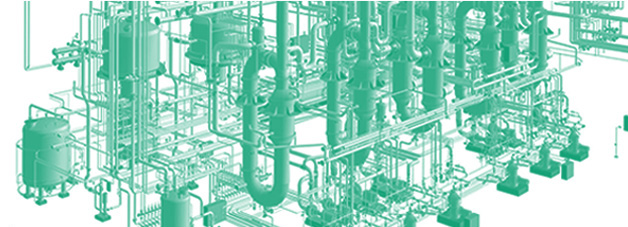Explosives
Contact Persons
... for TNT are:
Tel. +49 - 221 - 37 92-0
Fax +49 - 221 - 37 92-299
Trinitrotoluene
TNT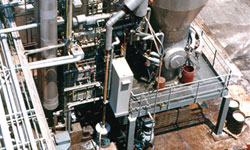
2,4,6-Trinitrotoluene, produced either from Toluene or ortho-Mononitrotoluene with mixed acids, mainly serves for military purposes and to a minor degree is also used in dynamite production.
Along with the equipment for nitration, sulphitation, drying and granulation, MEISSNER offers complete TNT plants also including an acid reconcentration plant and a waste water regeneration plant. The MEISSNER TNT process is characterized by the application of the countercurrent principle from one nitration step to the other, each nitration step constituting a separate unit, though. As a consequence, the qualities of the intermediate products Mononitrotoluene and Dinitrotoluene as well as of the product 2,4,6-Trinitrotoluene meet the high demands of military uses.
Contact Persons
... for Nitrocellulose, HMX/RDX, Nitropenta, Nitroglycerine and Nitroglycols are:
Tel. +49 - 221 - 37 92-0
Fax +49 - 221 - 37 92-299
Octogen, Hexogen, Nitropenta
HMX, RDX, PETN
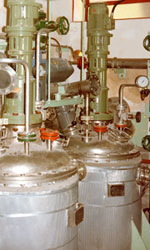
Octogen, presently the most powerful high-efficiency explosive, is produced from Hexamethylenetetramine according to the Acetic Acid process, and is used for special military purposes.
Hexogen can be produced either by the Acetic Acid process or according to the conventional Nitric Acid process, and is mostly processed to Compound B.
Nitropenta, a Nitric Acid ester of Pentaerythritol, is obtained by the Nitric Acid process. Apart from military applications, Nitropenta is mainly used in the civil explosives industry to be processed to detonating cords, and it is an essential component of detonating caps.
MEISSNER supplies complete plants for these explosives using the processes mentioned above, as well as plants for their further processing to Compound B, Octol, plastic explosives, etc.
Nitroglycerin and Nitroglycols
NG, DNG, DEGDN, TEGDN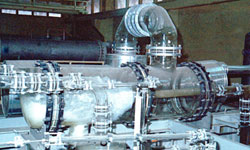
Nitroglycerin and Nitroglycols are produced from the respective alcohols with anhydrous mixed acids by means of the MEISSNER injector process and are used for military purposes (propellants) as well as in the civil explosives industry (dynamite).
MEISSNER injector plants are characterized by on-line mixing of the acids (mixed acid store not necessary), small production quantities in the nitration cycle, dynamic separation of the product from the spent acid, and automatic discharging in case of power outage or shutdown.
Along with the complete injector plant, MEISSNER offers the corresponding equipment for the transport of Nitroglycerin/Nitroglycol (emulsion transport), for the storage (emulsion store), and for the weighing process.
Together with plants for the production of Nitroglycerin and Nitroglycols, MEISSNER as main contractor also offers acid regeneration plants.
Nitrocellulose
NC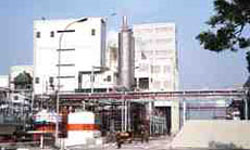
The nitration (esterification) of Cellulose with a mixture of Nitric and Sulfuric Acid was discovered in the mid-19th century by the German chemist Schoenbein. The special properties of Nitrocellulose (NC) soon found wide application, e.g. in the explosives industry, and led to Nobel's development of dynamite.
Still today, Nitrocellulose is an important ingredient of explosives mixtures, such as propellants like single-, double- and triple-base powders as well as rocket propellants, or the above-mentioned dynamites.
The process as offered by MEISSNER is the result of long-standing development work and decades of experience in the manufacture of all grades of Nitrocellulose.
The main features of this highly modern Nitrocellulose process are:
- continuous nitration
- recovery of adhered acids
- efficient absorption of nitrous fumes
- application of a heat-recovery system
- application of the latest refiner technology
- continuous dehydration and alcoholization of Nitrocellulose
- highest safety standards
- improved product qualities.
The flexibility and efficiency of the process allow for the production of all grades of Nitrocellulose and perfectly combine economic efficiency, safety, and environmental aspects.
Contact Persons
... for Explosives Processing, Initiating Explosives are:
Tel. +49 - 221 - 37 92-0
Fax +49 - 221 - 37 92-299
Explosives Processing
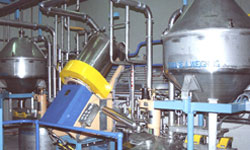
MEISSNER is specialised in plants and machinery for the processing of explosives and related items and offers the following products and services for the Defence Industry.
Ammunition Filling Plants
Plants and equipment for filling, cooling, testing and final assembly including packing of all types of ammunition are designed according to customer's requirements. The special features of MEISSNER ammunition filling plants are:
- Universal applicability for various types of ammunition
- Design for processing of TNT and all TNT-based mixed explosives (TNT/RDX, TNT/HNS, TNT/NTO, TNT/HMX, Tritonal, H6, HBX-3 etc.), as far as these are meltable and pourable
- High flexibility due to modular conversion kits
- High and uniform product quality
- Optimum safety by computerised process and production monitoring
- Clean and safe working places
- Numerous reference plants
Plants for Melting and Mixing of Explosives
- Special plants for the processing of high-viscosity explosives mixtures with and without aluminium
Special Filling Plants for Vacuum Casting
- Developed for the manufacture of high-performance shaped charges and warheads
Special Cooling Processes
- Cooling of filled shells in hot-probing units according to the well known and well proven MEISSNER hot-probing process in one operating step
- Tailor-made cooling equipment for shaped charges and warheads
Plants for Manufacture of Pressed Charges
- Equipment and machinery for the manufacture of pressed charges of any kind of explosive
Plants for Dosing and Loading of Propellants
- Equipment and machinery for loading of propellants into cartridge cases, bags, etc.
Special Machines for Assembly of Ammunition
- Special machines for crimping, weighing, assembly of fuses or primers, painting, marking, etc.
At-Site Service
- Development of new products or applications by MEISSNER experts at customer's plant site
Initiating Explosives
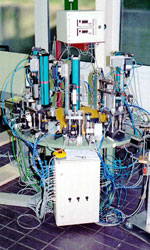
Primary explosives are highly sensitive materials that may explode even with slight mechanical, thermic or electrostatic influence. They are mainly used in blasting caps, detonators and other means of ignition where they serve as initiators of ignition chains for all kinds of explosives.
The production of Lead Azide and Lead Trinitroresorcinate is carried out either batch-wise in a precipitation vessel or, using the continuous process developed by MEISSNER, in a precipitation column. Both processes are applied by various explosives manufacturers world-wide and are well proven with regard to performance, product quality and safety.
During the past few years, MEISSNER has been able to essentially improve the continuous as well as the discontinuous process concerning automation and safety. MEISSNER has developed a modern plant conception which already corresponds to the tightened safety regulations established by plant users and authorities or which can be easily adapted accordingly.
Lead Azide
Lead Azide is a white to slightly yellow crystalline solid used in blasting caps, detonators and other ignition devices. It is a powerful primary explosive which, in its pure form, is very sensitive. In order to reduce the sensitivity, to modify the crystal shape and size and to improve further processing, several additives (e.g. dextrine, CMC, gelatine, …) are used during the precipitation process.
The continuous production according to the MEISSNER process is performed in a precipitation column. The starting solutions, Sodium Azide solution and a water-soluble lead salt, are separately dosed into the precipitation column. The crystals resulting from the reaction are removed together with the mother lye at the bottom discharge valve. The mixture of crystals and mother lye is separated on a special filter, and the Lead Azide is washed with water and alcohol and then dried. After drying, the product is sieved and weighed in portions matching the requirements of further processing. All production steps are automated and can be operated by remote control, which guarantees a high safety standard for the operator.
Lead Styphnate (Lead Trinitroresorcinate)
Lead Trinitroresorcinate (PbTNR) is obtained by treating Trinitroresorcinol (TNR) with lead salts. Depending on the respective recipe and the reaction conditions, it is possible to generate various modifications of the product. However, preference is usually given to the neutral PbTNR, which can be used as universal primary explosive. For example, PbTNR is a constituent of priming compositions in priming caps (Sinoxide). Furthermore, small quantities of PbTNR are mixed with Lead Azide in order to improve the ignition qualities of blasting caps.
Beside the manufacture by batch process, PbTNR can also be produced according to the continuous MEISSNER process in a precipitation column. Since the water solubility of TNR is quite low, TNR is dissolved as a magnesium salt and brought to reaction with a lead salt solution. The further procedure is identical with the process described above for obtaining Lead Azide.
Tetrazene
Tetrazene is a white powdery product. It is not applied in its pure form, but represents an important component in a large number of ignition compositions due to its high impact on the ignition sensitivity of those mixtures. Usually only small quantities of 2-5 % of Tetrazene are added to the mixtures and thus batch production of Tetrazene is sufficient.
The starting materials for the production of Tetrazene are Aminoguanidine Sulphate (AGS) and Sodium Nitrite. The AGS solution is prepared in a heatable vessel with stirrer and the Sodium Nitrite solution is added slowly. After having been heated up to 40 °C, Tetrazene begins to crystallise. After the crystallisation process, the composition is cooled down to room temperature and the product is filtered. After several washing steps, the product is dried and portioned. During the whole process, the operator's contact with the product is reduced to a minimum.
Mother Lye and Effluent Treatment
MEISSNER's special attention focuses on the reliable destruction of residual explosives in the respective mother lyes combined with an intelligent, custom-tailored, and advanced waste-water treatment.
Machines for Processing of Primary Explosives
Additionally to plants for the individual explosives mentioned above, MEISSNER offers equipment for mixing, loading and/or pressing initiating mixtures. Therefore, a fully automatic detonator loading and pressing machine can optionally also be supplied by MEISSNER. In several successive work stations this machine provides loading of primary and secondary explosives into metal shells or caps, as well as their subsequent assembly. Depending on the design of the detonator, the capacity of this machine ranges from 500 up to 1,000 pieces per hour.
Styphnic Acid (Trinitroresorcinol)
Depending on its puritiy, Trinitroresorcinol (TNR) is a yellow or yellow-brown crystalline product. It is a weak explosive and serves as starting material for the production of the above-mentioned primary explosive PbTNR.
For the production of TNR according to the MEISSNER process, Resorcinol is used as raw material. First Resorcinol is sulphonated and afterwards nitrated with highly concentrated Nitric Acid to obtain Trinitroresorcinol. In a centrifuge the product is separated from the spent acid, washed several times and stored in a water-wet state before being further processed.
Alternatively, MEISSNER also offers sulphate-free nitration processes for the production of TNR.
.

 DE
DE  EN
EN 